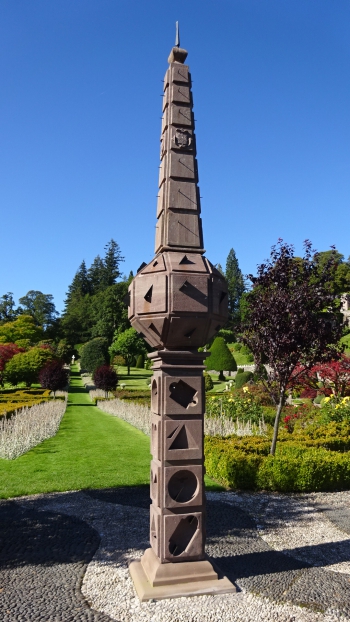
The sundial consists of 61 multiple dials on raised panels and in sunken hollows. The date of the sundial is 1630. It has been made as an exhibition piece to show all of the sundial mathematics of its era.
The sundial obelisk at Drummond Castle in Perthshire has a long and distinguished history. It has its place in the architecture of the ancient castles and houses in Scotland. It is connected with the very earliest days of the British Sundial Society (BSS). And it is one of the most important free-standing sundials in the British Isles from the early 1600s still surviving.
In 2017 after almost four hundred years outdoors the sundial was showing serious signs of the stone deteriorating. The whole structure was feared to be unsound. Making it safe had become urgent. In the early months of that year the sundial was completely dismantled, removed to specialist workshops in Edinburgh, and a programme of total restoration and conservation treatment was approved.
As work progressed significant gnomonic features of the sundial became apparent, which had not been recognised before. Preconceptions about the function of the sundial, which had probably circulated for 150 years or more, were properly corrected. It is in fact a compendium of mathematical sundial design of its era. It includes hours from sunrise, hours before sunset, seasonal hours, common hours, solstices and equinoxes. None of the dials show the time of world cities as was always believed. The key to all of this is an inscription carved into the stone on a scroll in Latin.
A full history of the sundial leading up to its reinstatement in the gardens at Drummond Castle on 23 June 2019 is contained in an article written for the BSS, which you can read here: Drummond Castle Obelisk Sundial Restoration – Part 1 History and Reinstatement.
